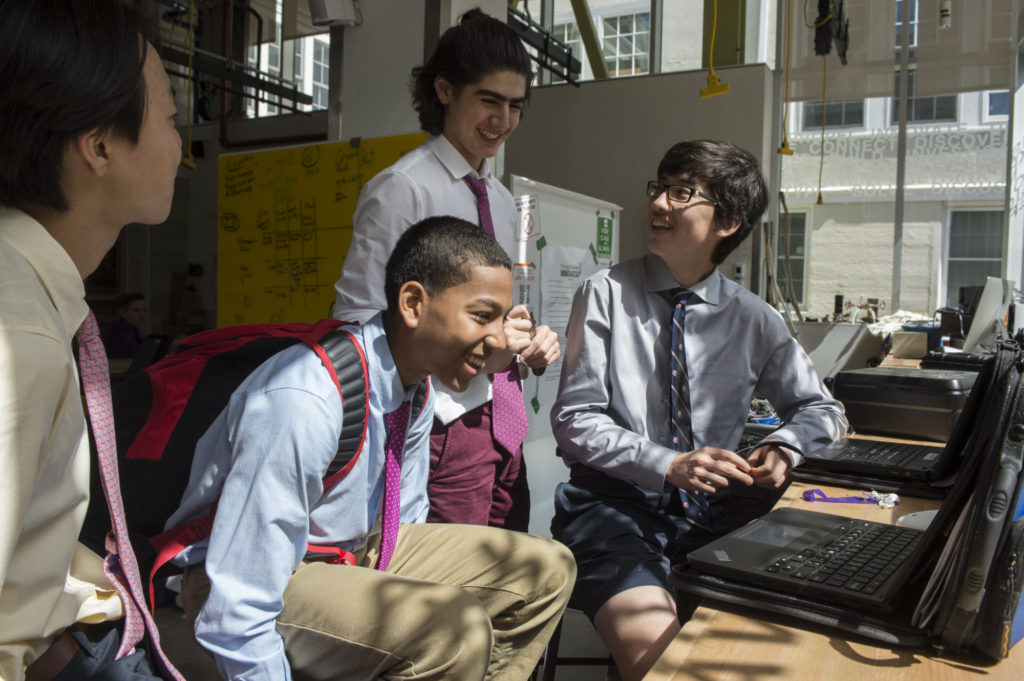There are many opportunities for educators to help Middle School boys develop good decision-making skills. The 21st-century learning approach, which promotes mastery of the “six Cs” (critical thinking, communication, collaboration, creativity, character, and cross-cultural competency), is well suited for developing this skill. Of the six Cs, there are two that work in tandem and are particularly important in developing good decision-making skills—critical thinking and collaboration.
 Impact of Critical Thinking for Students
Impact of Critical Thinking for Students
Critical thinking and collaboration in the classroom are the two Cs that nurture good decision-making in Middle School boys. Decision-making abilities emerge in boys with the onset of puberty, between ages 9 and 14. This is a time when their worldview is taking shape, and they are beginning to establish their own set of values based on their personal experiences and the values instilled in them by family and community circles. Rather than accepting information at face value, your son may start asking more questions and even engaging in debate.
Shani Charles, Fessenden’s Middle & Upper School Director of Teaching and Learning, says boys at this age “know right from wrong but they need a little guidance and sensitivity in making decisions.”
Why is Critical Thinking So Important?
Critical thinking is a foundational set of intellectual skills that should be a focus in every classroom.
Critical thinking includes a wide variety of cross-disciplinary intellectual skills. As defined by the Great Schools Partnership, critical thinking examples may include:
-
- Developing well-reasoned, persuasive arguments and evaluating and responding to counter arguments
- Examining concepts or situations from multiple perspectives, including different cultural perspectives
- Questioning evidence and assumptions to reach novel conclusions
- Devising imaginative ways to solve problems, especially unfamiliar or complex problems
- Formulating and articulating thoughtful, penetrating questions
- Identifying themes or patterns and making abstract connections across subjects
Educators should encourage critical thinking through hands-on activities and projects. In literature, a student might explore different character perspectives by rewriting a scene from another character’s point of view. In science, students might be asked to question the source of a given research study and investigate the motivation behind the study to assess its credibility.
It is important to give students the opportunity to apply critical thinking skills to global issues or everyday social challenges. For example, in Fessenden’s eighth grade science class, the boys use what they have learned about electricity and programming to come up with a feature that will make a home more environmentally-friendly. This type of real-world application helps develop their social-emotional skills and better prepares them to make decisions in their own world.
Impact of Collaboration for Middle School Students
Collaboration provides the opportunity for Middle School students to put their critical thinking skills to work.
The benefits of collaboration extend beyond the classroom and build on a student’s critical thinking aptitude and decision-making skills.
At our boarding and independent school, group work is central to its project-based curriculum precisely because it is a very effective way to build collaboration and critical thinking skills, among others. “In a small group, each student has voice and choice in what to do to meet the challenge. They brainstorm and come up with a plan together. It is an iterative process, so students might run into bugs during the coding process, for example, and need to fix them or redirect the project altogether, “ explains Charlie Danziger, Upper School science teacher.

Charlie also shares, “Those who don’t run into failure aren’t learning nearly as much as those who do. Having a couple of people collaborate on that makes it all the better. There are different skill sets and ideas that come to fruition.”
Most educators agree that providing ample opportunities for students to enhance their collaborative skills is critical to preparing them for the world they will inherit.
Critical Thinking and Collaboration Benefit a Student Beyond the Classroom
Today, the ability to think critically and work with others to achieve a common goal is highly coveted in the workplace, and certainly an asset to building healthy relationships.
Students often look forward to group work because it gives them a chance to socialize and be part of a team. All the while, they are honing their ability to listen and to engage in discourse that is based on respect.

According to an article by the National Education Association, there are many benefits to collaboration in the classroom, including nurturing creativity through group brainstorming, helping a student get to know himself better, and providing the student opportunities to apply the critical thinking skills he has been working on across the curriculum.
When critical thinking and collaboration are fostered in the classroom and practiced by strong role models both at school and at home, boys develop effective decision-making skills based on respect, perspective-taking, and reason. A skill set that will serve them throughout their education, career, personal life, and community life.
Learn More About The Fessenden School’s Curriculum
What is 21st Century Learning? It is an approach that focuses on mastering the “six Cs”: critical thinking, communication, collaboration, creativity, character, and cross-cultural competency. Our New England boarding school also offers Life and Leadership courses, where students have the opportunity to role-play real-life scenarios with their peers and develop awareness of self and others while honing skills for good decision-making.
Read On

Surprising Facts About Dorm Life at a Junior Boarding School

3 Insider Admissions Tips for Junior Boarding School Hopefuls

